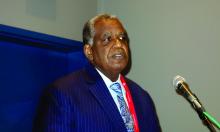CHICAGO – Firibastat, a first-in-class oral antihypertensive drug, proved safe, effective, and well-tolerated in NEW-HOPE, a phase 2b clinical trial focused on an understudied and underserved patient population composed largely of overweight or obese, high-risk, hypertensive racial minorities,
Firibastat is the first brain aminopeptidase A inhibitor. It selectively and specifically inhibits conversion of angiotensin II to angiotensin III, which exerts tonic stimulation over blood pressure. Decreased angiotensin III means less release of vasopressin, reduced sympathetic nervous system activity, and increased baroreflex activity, all of which add up to lower blood pressure, Keith C. Ferdinand, MD, explained at the American Heart Association scientific sessions.
NEW-HOPE (Novel Evaluation With QGC001 in Hypertensive Overweight Patients of Multiple Ethnic origins) was an open-label multicenter study including 254 middle-aged or older hypertensive patients. Two-thirds were obese, the rest overweight. Participants had a mean body mass index of 33 kg/m2 and a baseline automated office blood pressure (AOBP) of 153.9/91.5 mm Hg. A total of 46% were women, and 38% were black. Indeed, blacks and other minorities made up 54% of the NEW-HOPE population.
“Minority populations in many of the clinical trials in hypertension have been underrepresented,” observed Dr. Ferdinand, professor of medicine at Tulane University in New Orleans.
After a 2-week washout period, all patients were placed on firibastat at 250 mg b.i.d. for 2 weeks. If at that point their AOBP was more than 140/90 mm Hg they were bumped up to 500 mg b.i.d. Hydrochlorothiazide at 25 mg/day could be added 1 month into the trial if a patient’s systolic blood pressure was 160 mm Hg or more or their diastolic blood pressure was at least 100 mm Hg. Of note, 85% of patients were able to remain on firibastat monotherapy throughout the study.
The primary endpoint was change from baseline in systolic AOBP at 8 weeks. By week 8, the mean systolic blood pressure (SBP) had fallen by 9.7 mm Hg from a baseline of 153.9, which in hypertension circles is deemed a clinically meaningful improvement. Mean diastolic AOBP fell from 91.5 to 87.2 mm Hg, for a 4.3–mm Hg reduction.
“The diastolic number was smaller, but remember, this was a middle-aged and older population, and SBP is the most important endpoint in patients of that age, not just in clinical trials but in terms of its effects on morbidity and mortality,” Dr. Ferdinand said.
A word about the rigorous AOBP protocol used in NEW-HOPE: It was similar to that used in the landmark SPRINT trial. Patients were required to rest seated with back support in a quiet room with no talking for 5 minutes. Then six measurements were taken at 1-minute intervals, with patients’ legs uncrossed and feet on the floor the whole time. The first measurement was discarded, and the next five were averaged.
“This correlates very well with daytime ambulatory blood pressure, which is the gold standard,” the cardiologist noted.
In a prespecified subgroup analysis, systolic AOBP was reduced significantly more in obese than in overweight patients. Black patients averaged a 10.5–mm Hg decrease, nonblacks a 4.1–mm Hg reduction. But black patients also averaged a 2.0 kg/m2 higher body mass index.
“ACE inhibitors and angiotensin receptor blockers have been shown to be less efficacious in black patients. Firibastat, however, had similar effects in both black and nonblack patients. And this is probably one of the main take-away points of the study: This is a drug based on the phenotype of obesity and increased blood pressure, and the drug had efficacy regardless of self-identified race,” the cardiologist continued.
The most common treatment-emergent adverse events were headache in 4% of patients and skin reactions in 3%. There were no cases of angioedema. The only serious adverse event was one case of erythema multiforme. There were no clinically meaningful changes in any laboratory parameters.
Based upon these encouraging results, a pivotal phase 3 clinical trial is being planned in patients with difficult-to-treat or resistant hypertension. Dr. Ferdinand sees firibastat as being particularly useful as part of a two-drug treatment strategy, probably with the addition of a calcium channel blocker or potent diuretic, since “two drugs is the way to go in resistant hypertension.”
Audience members called the study “very hopeful,” but wondered about the absence of a placebo control arm. Reservations were also voiced about the need for twice-daily dosing of firibastat because it’s well established that adherence drops off when an antihypertensive agent has to be taken more than once daily.
Dr. Ferdinand said the lack of a placebo arm in NEW-HOPE was endorsed by the Food and Drug Administration because of ethical concerns surrounding use of a placebo in a high-risk population such as this. Obesity is known to increase the risk of resistant hypertension fivefold. Obesity is more common in blacks and Hispanics, with a prevalence of 47%, than in whites, where the prevalence is 38%.
As for the b.i.d. dosing, Quantum Genomics, the company that sponsored NEW-HOPE, is developing a sustained-release, once-daily formulation of firibastat that’s better suited for clinical practice, he added.
NEW-HOPE was carried out in collaboration with the Association of Black Cardiologists. Dr. Ferdinand reported serving as a consultant to Quantum Genomics and a handful of other pharmaceutical companies.

